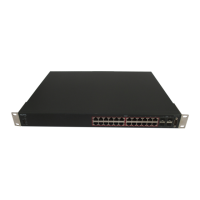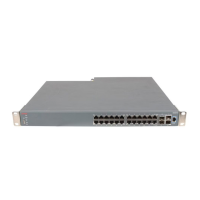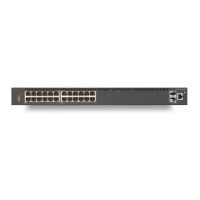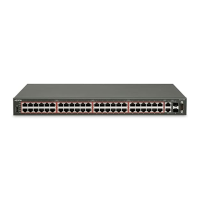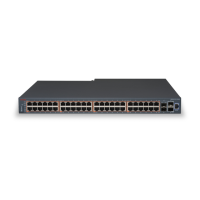





Do you have a question about the Avaya 4000 Series and is the answer not in the manual?
| Brand | Avaya |
|---|---|
| Model | 4000 Series |
| Category | Network Router |
| Language | English |
Describes the guide's purpose and scope for troubleshooting the Avaya Ethernet Routing Switch 4000 Series.
Lists documentation and training resources for the Avaya Ethernet Routing Switch 4000 Series.
Provides information on accessing the Avaya Support website for documentation, notices, and service requests.
Introduces the new features detailed in this chapter for Release 5.7.
Explains the SLA Monitor feature, its phase 1 and 2 implementations, and CLI capabilities.
Details support for IEEE 802.3at-2009 standard for LLDP configuration with Powered Devices (PD).
Explains how to allow users to change RADIUS account passwords when they expire.
Describes Link-state tracking (LST) for creating network redundancy by binding multiple interface link states.
Explains using scripts for configuring Avaya stackable Ethernet Switches in default or verbose modes.
Details a feature to block subsequent MAC authentications if the RADIUS-assigned VLAN differs.
Introduces a new mode for EAP/NEAP clients when RADIUS servers become unreachable.
Ensures ports with RADIUS Non-EAP authentication are assigned to at least one VLAN for authentication.
Introduces syslog messages for 802.1X/EAP/NEAP/UBP authentications for better troubleshooting.
Explains the trace feature for detailed information about errors and events for troubleshooting 802.1X/EAP.
Describes Remote Switch Port ANalyzer (RSPAN) for enhanced port mirroring using an intermediate VLAN.
Introduces Shortest Path Bridging MAC (SPBM) for scalable Ethernet network virtualization.
Outlines proactive steps to minimize troubleshooting needs and improve effectiveness.
Explains the port mirroring feature for monitoring and analyzing network traffic, supporting ingress and egress.
Guides on using port mirroring commands for diagnostics and information gathering.
Details RSPAN considerations, configuration, and port limitations.
Lists considerations for using RSPAN VLANs, including deletion, port membership, and mapping.
Explains using RSPAN commands for diagnostics and information gathering.
Describes using port statistics commands to display received and transmitted packet information.
Explains stack loopback tests to determine issues with stack cables or ports.
Details using stack health check for confirming stack operation and continuity.
Explains Stack Forced Mode for managing standalone switches from a broken stack of two.
Explains using syslog messaging for managing event messages and troubleshooting.
Details the backup config file feature for saving switch configurations to FLASH.
Describes the ASCII Download Log feature for logging results of configuration file downloads.
Provides CPU and memory utilization data for monitoring system performance.
Lists enhanced show commands for displaying more detailed system information.
Explains Address Resolution Protocol (ARP) for finding hardware addresses using network layer addresses.
Details Dynamic ARP inspection as a security feature to validate ARP packets and protect against attacks.
Explains MAC Flush for quickly removing MAC addresses from the MAC table to troubleshoot FDB corruption.
Describes using MLT/DMLT trunk to detect network connectivity issues and related commands.
Details SNMP traps generated by the switch for DHCP Snooping, Dynamic ARP Inspection, and IP Source Guard.
Explains DHCP relay for enabling IP configuration for clients on different subnets.
Details Auto Unit Replacement (AUR) for replacing failed devices in a stack while retaining configuration.
Explains DAUR for updating the diagnostic image of non-base units in a stack.
Explains IGMP snooping and how the switch forwards multicast traffic.
Discusses IPv6 dual-stack configuration and its support for management purposes only.
Guides on interpreting LEDs on the unit for diagnostic and operational information.
Describes the Knowledge and Solution Engine as a searchable database of Avaya technical documents.
Lists and explains the different command modes available in ACLI for configuration and troubleshooting.
Outlines essential information to gather before contacting Avaya Technical Support for troubleshooting.
Introduces Emergency Recovery Trees (ERTs) as a quick reference for troubleshooting common failures.
Lists the available emergency recovery trees and their corresponding page numbers.
Explains flash corruption issues due to power outages or environmental factors and recovery steps.
Shows the recovery tree for issues related to a corrupted flash.
Addresses issues where clients cannot communicate due to incorrect PVID settings on ports.
Illustrates the recovery tree for discovering and correcting incorrect PVID issues.
Identifies issues where uplink ports are not tagged to a VLAN, causing communication problems.
Shows the recovery tree for troubleshooting VLAN communication issues related to untagged uplink ports.
Discusses SNMP failure troubleshooting, focusing on trap configurations when a device is reachable.
Presents figures showing the SNMP recovery tree for troubleshooting trap issues.
Addresses stack failure causes, typically related to cabling errors or multiple base units.
Explains that figures show the stack recovery tree for diagnosing stacking problems.
Explains DHCP and DHCP relay errors, often on the client-side, and potential configuration issues.
Shows the DHCP relay recovery tree for identifying and resolving common DHCP relay issues.
Addresses scenarios where stack unit configurations are not saved to the base unit, often due to disabled AUR Auto-Save.
Shows the recovery tree to save stack unit configurations to the base unit, checking AUR status.
Troubleshoots the issue where both units in a two-unit stack incorrectly show 'Ready for Replacement'.
Explains DAUR for new units copying diagnostic images from an existing stack if images differ.
Provides a recovery tree for issues where a new unit fails to copy the diagnostic image from the stack.
Guides on using the recovery tree when unable to access a standalone switch via its stack IP address after a stack break.
Provides a recovery tree for scenarios where network access to a stack IP address fails, even with Stack Forced Mode enabled.
Guides on using a recovery tree when the 'show stack health' command shows 'LINK DOWN' or 'MISSING'.
Shows the recovery tree for diagnosing 'LINK DOWN' or 'MISSING' status in stack health check columns.
Guides on using a recovery tree when the 'show stack health' command shows 'UP WITH ERRORS'.
Shows the recovery tree for diagnosing 'UP WITH ERRORS' status in stack health check columns.
Introduces a workflow to determine solutions for common hardware problems.
Guides on confirming power delivery to the device, noting voltage ranges.
Provides a task flow to confirm the device is powered correctly.
Guides on confirming the power cord is properly installed and operational.
Explains interpreting console messages and LED status for failure diagnosis.
Details reloading agent code to eliminate corrupted code causing partial boot issues.
Guides on replacing a power cord to resolve power issues, emphasizing model matching.
Provides instructions for returning a unit to Avaya for repair and RMA information.
Guides on confirming stacking cable connections and reviewing requirements.
Provides a task flow to confirm correct installation of stacking cables.
Guides on ordering and using appropriate cascade cables for fail-safe stacking.
Guides on reviewing documentation for correct stacking cabling requirements.
Guides on confirming port and Ethernet cable configuration.
Provides a task flow to check the port and Ethernet cables.
Guides on reviewing port information to ensure the port is enabled.
Addresses issues with combo or shared ports where SFP is active but copper port is not.
Guides on enabling a port using specific interface commands.
Guides on ensuring cables connected to the port are functioning correctly.
Guides on confirming fiber port functionality and correct cable type.
Provides a task flow to confirm fiber port cable functionality and type.
Guides on reviewing fiber port information to ensure the port is enabled.
Guides on enabling a fiber port using specific interface commands.
Guides on confirming fiber optic cables connected to the port are working.
Guides on ensuring the fiber type and SFP/XFP installation are correct.
Provides instructions for returning a unit for repair and obtaining RMA information.
Details using AUR and DAUR for replacing failed stack units, noting software version requirements.
Provides a task flow for replacing a stack unit, appropriate when old software is used or AAUR is disabled.
Guides on removing a failed unit from the stack while maintaining power.
Guides on confirming the Auto Unit Replacement (AUR) feature is enabled in the stack.
Explains removing MAC addresses for non-operational stack switches from the AUR cache.
Guides on verifying that a new device has the identical software version before insertion into the stack.
Guides on obtaining and installing the correct software version, including a caution on backups.
Guides on placing a new unit in the stack where a failed unit was connected.
Guides on reconnecting stacking cables to correctly stack a device.
Guides on energizing a new unit after connection and integration into the stack.
Clarifies ADAC VLAN settings are dynamic and not saved to nonvolatile memory.
Introduces a workflow to help identify ADAC-related problems.
Addresses correcting issues with IP phones not being detected by ADAC.
Provides a workflow to resolve IP phone detection issues with ADAC.
Guides on configuring VLAN filtering to allow ADAC to detect IP phones.
Provides a task flow to correct VLAN filtering for ADAC.
Guides on ensuring ADAC MAC addresses are properly loaded in the range table.
Provides a task flow to place ADAC MAC addresses in the range table.
Explains reducing LLDP devices as more than 16 can cause detection issues.
Provides a task flow to reduce the number of LLDP devices on the system.
Addresses issues that may interfere with automatic configuration of devices.
Provides a task flow to solve auto configuration issues.
Guides on correcting auto configuration issues, potentially caused by tagged frames mode.
Guides on displaying the global status of ADAC and checking the operational state.
Explains configuring call server and uplink ports to assist with auto configuration.
Guides on replacing a unit to replicate configuration if AUR is enabled.
Addresses auto configuration stopping after a unit is removed from the stack.
Provides a task flow to correct auto configuration issues related to device status.
Shows typical authentication problems and their corresponding troubleshooting workflows.
Guides on changing RADIUS passwords, including prerequisites and CLI commands.
Introduces Fail Open VLAN Continuity Mode for EAP/NEAP clients when RADIUS servers are unreachable.
Provides troubleshooting guidelines for EAP and NEAP features on the switch.
Offers a workflow to determine the cause and solution for EAP clients not authenticating correctly.
Guides on ensuring the RADIUS server has connectivity to the device.
Provides a task flow to restore the connection to the RADIUS server.
Offers troubleshooting guidelines for obtaining correct RADIUS server settings.
Guides on pinging the RADIUS server to ensure connection existence.
Details requirements for enabling EAP on a PC network card.
Provides a task flow to ensure the PC network card has EAP enabled.
Explains the PC hardware and configuration requirements for EAP support.
Guides on applying the correct EAP method.
Provides a task flow to apply the correct EAP method.
Guides on configuring the RADIUS server for authentication using MD5.
Guides on enabling EAP globally on the 4000 Series device.
Provides a task flow to enable EAP globally on the device.
Guides on reviewing EAPOL settings to ensure EAP is enabled.
Guides on setting the EAPOL port administrative status to auto.
Addresses eliminating multiple authentications of users.
Provides a workflow to determine the cause and solution for EAP multihost authenticating repeatedly.
Explains lowering eap-mac-max to match the exact number of EAP users to prevent issues.
Guides on obtaining the exact number of EAP users reaching the allowed maximum.
Guides on lowering the eap-mac-max value to match the number of users.
Guides on changing the EAPOL request packet generation to unicast.
Provides a task flow to set the EAPOL request packet to unicast.
Ensures the RADIUS VLAN is applied correctly to support EAP.
Provides a workflow to determine the cause and solution for RADIUS VLANs not being applied.
Guides on correcting discrepancies in VLAN information at the RADIUS server.
Provides a task flow to ensure VLAN is configured at the RADIUS server.
Offers troubleshooting guidelines for obtaining correct RADIUS server settings.
Guides on obtaining RADIUS information to identify settings.
Guides on configuring the RADIUS server with correct VLAN information.
Ensures the VLAN is configured correctly on the Avaya Ethernet Routing Switch.
Provides task flows to configure the VLAN on the device.
Guides on identifying EAPOL multihost information and the state of RADIUS assigned VLANs.
Guides on changing the 'allow RADIUS assigned VLAN' setting to enable.
Guides on displaying EAPOL interface information and the status of ALLOW RADIUS VLANs.
Guides on displaying VLAN config control information and identifying if it's set to strict.
Guides on setting VLAN config control to flexible to avoid complications with strict settings.
Guides on viewing VLANs added to the desired STG and their relation to RADIUS assigned VLANs.
Guides on configuring the RADIUS assigned VLAN to the correct Spanning Tree Group.
Addresses correcting a MAC address configuration to allow authentication.
Offers a workflow to determine the cause and solution for a configured MAC not authenticating.
Provides task flows to ensure MAC authentication is working on the device.
Guides on displaying EAPOL port information and ensuring EAP is enabled.
Guides on making changes for global EAP enabling and port status to auto.
Guides on displaying EAPOL multihost information and noting if Non-EAPOL clients are enabled.
Guides on correcting the non-EAPOL client attribute.
Guides on correcting the non-EAP client attribute and enabling multihost status.
Guides on displaying EAPOL multihost interface information and noting MAC addresses.
Addresses correcting non-EAP RADIUS MAC authentication issues.
Offers a workflow to determine the cause and solution for RADIUS MAC authentication problems.
Guides on correcting switch configuration to resolve RADIUS MAC issues.
Provides task flows to configure the switch for RADIUS MAC issues.
Guides on displaying EAPOL port information and ensuring EAP status.
Guides on making changes for global EAP enabling and port status to auto.
Guides on displaying EAPOL multihost information and noting RADIUS authentication for Non-EAPOL clients.
Guides on making RADIUS server changes to authenticate non-EAPOL clients.
Guides on making RADIUS server changes to the password format.
Guides on reviewing EAPOL multihost interface information.
Guides on making RADIUS server changes to authenticate non-EAP clients.
Addresses RADIUS server requiring correct MAC address and password for authentication.
Provides a task flow to configure the RADIUS server with correct MAC and password.
Addresses ensuring the switch is correctly configured for non-EAP MHSA MAC authentication.
Offers a workflow to determine the solution for MHSA MAC authentication issues.
Guides on configuring the switch to enable MHSA.
Guides on displaying EAPOL port information and ensuring EAP status.
Guides on making changes for global EAP enabling and port status to auto.
Guides on displaying EAPOL multihost information and noting RADIUS authentication for Non-EAPOL clients.
Guides on identifying reasons for EAP/non-EAP port shutdowns and making configuration changes.
Offers a workflow to determine solutions for EAP/non-EAP ports experiencing shutdowns.
Provides a task flow to allow an increased number of unauthorized clients on ports.
Guides on displaying log information to provide additional troubleshooting details.
Guides on displaying EAP/non-EAP client information on a port.
Guides on displaying EAPOL port information and observing log output.
Provides troubleshooting guidelines for changing EAP settings and cleaning up old MAC addresses.
Addresses authentication failures when a port is not a member of a VLAN.
Lists commands for viewing password fields and padding when configuring RADIUS passwords.
Guides on using trace to observe software module status, with notes on trace levels.
Details a feature to block subsequent MAC authentications if the RADIUS-assigned VLAN differs.
Guides on using separation commands to disable EAP clients without disabling NEAP clients.
Details support for IEEE 802.3at-2009 standard for LLDP configuration with Powered Devices (PD).
Explains using scripts for configuring Avaya stackable Ethernet Switches in default or verbose modes.
Describes Link-state tracking (LST) for creating network redundancy by binding multiple interface link states.
Introduces a workflow to identify common IPv6 troubleshooting scenarios.
Addresses ping failures when pinging an IPv6 address from another host.
Provides task flows to restore IPv6 connectivity when pinging fails.
Guides on verifying IPv6 global admin status and interface status.
Guides on enabling IPv6 on the management VLAN and ensuring admin-status.
Guides on configuring an IPv6 address for the device.
Guides on displaying IPv6 global information for the device.
Guides on enabling IPv6 on the device.
Guides on setting the IPv6 default gateway address.
Guides on displaying IPv6 interface information and checking preferred status.
Guides on displaying logging information and looking for duplicate address detection failure messages.
Guides on configuring a new IPv6 address for the device.
Guides on configuring a new link-local ID for IPv6.
Addresses ping failures when pinging an IPv6 address from the device console.
Provides task flows to restore IPv6 connectivity when pinging fails from the console.
Guides on displaying IPv6 neighbor information and checking neighbor state.
Guides on checking the IPv6 integrity of a remote host.
Addresses duplicate global IPv6 address detection, indicating another node has the same address.
Provides task flows to restore IPv6 connectivity when duplicate global addresses are detected.
Addresses duplicate link-local IPv6 address detection.
Provides task flows to restore IPv6 connectivity when duplicate link-local addresses are detected.
Guides on viewing the system log for duplicate address detection failure messages.
Guides on changing the 64-bit identifier for the link-local address.
Addresses inability to connect through the IPv6 default gateway.
Provides task flows to correct connections via the IPv6 default gateway.
Guides on checking the IPv6 default gateway status.
Guides on pinging the default gateway to check reachability.
Guides on using traceroute to identify the route to the gateway.
Addresses issues where IPv6 management traffic is not sent or received correctly.
Provides task flows to correct IPv6 management traffic issues.
Guides on viewing IPv6 interface statistics.
Guides on viewing ICMPv6 statistics.
Addresses connectivity issues for Telnet, Web, or SSH protocols using IPv6.
Provides task flows to correct IPv6 connectivity for Telnet, Web, or SSH.
Guides on viewing TCP statistics for IPv6.
Addresses UDPv6 communication issues.
Provides task flows to correct UDPv6 communication issues.
Guides on viewing UDP statistics for IPv6.
Guides on ensuring UDPv6 is enabled on the remote host.
Addresses failures when setting an IPv6 address due to exceeding interface limits.
Provides task flows for failures when setting an IPv6 address.
Guides on deleting an IPv6 address from the interface.
Guides on configuring a new IPv6 address for the device.
Guides on configuring a new gateway IPv6 address.
Introduces a workflow to resolve issues related to detecting SFPs or XFPs.
Describes procedures to ensure an XFP or SFP device is connected.
Provides task steps to ensure an XFP or SFP device is connected.
Guides on checking XFP/SFP documentation to confirm device support on the switch.
Guides on understanding limitations regarding unsupported XFPs or SFPs.
Guides on displaying GBIC device details.
Introduces a workflow to resolve multicast flooding issues.
Describes how to disable multicast flooding on a network.
Provides task steps to disable multicast flooding on the network.
Guides on displaying general IGMP snooping information in a specific VLAN.
Guides on displaying general IGMP snooping information and multicast groups in a specific VLAN.
Guides on displaying settings for flooding packets with unknown multicast addresses.
Guides on disabling multicast flooding.
Describes how to enable multicast flooding on a network.
Provides task steps to enable multicast flooding on the network.
Introduces a workflow to resolve RSTP SNMP trap issues.
Guides on ensuring RSTP SNMP traps are received.
Provides a task flow to ensure RSTP SNMP traps are received.
Guides on viewing the existing RSTP configuration.
Guides on enabling RSTP traps.
Guides on displaying the IP manager configuration.
Guides on enabling SNMP.
Guides on displaying the trap receiver configuration.
Guides on configuring an SNMPv1 trap receiver.
Guides on configuring an SNMPv2 trap receiver.
Guides on configuring an SNMPv3 trap receiver.
Guides on displaying the IS-IS configuration.
Guides on displaying the SPBM IS-IS configuration.
Guides on displaying SPBM Unicast FIB entries for nodes.
Guides on displaying VLAN to ISID associations.
Guides on verifying forwarding database (FDB) information.
Guides on verifying ISIS interfaces and receiving protocol control packets.
Guides on verifying UNI configuration.
Guides on verifying SPBM Unicast FIB entries for nodes.
Guides on verifying the SPBM network topology.
Guides on verifying SPBM Multicast FIB entries for traffic.
Guides on verifying LSDB information.
Guides on using CFM to diagnose the network.
Discusses support for NTR and RTP and their relationship with SLA Monitor Agent.
Introduces a workflow to identify common DHCP/BootP relay issues.
Lists DHCP/BootP relay troubleshooting topics and their page numbers.
Addresses issues when the forward path cannot be set, with specific error messages.
Provides a task flow to verify relay agent IP address configuration on the VLAN.
Guides on verifying relay agent IP address matches VLAN configuration.
Assists in identifying and correcting connectivity issues between clients and DHCP/BootP servers.
Identifies procedures to resolve connectivity issues between clients and DHCP/BootP servers.
Guides on viewing IP routing information and confirming it's enabled.
Guides on enabling IP routing globally on the switch.
Guides on viewing VLAN information and verifying interface status.
Guides on enabling IP routing on a specific VLAN.
Guides on viewing IP static routes for connectivity with servers not on the same subnet.
Guides on configuring the IP route.
Guides on viewing the global DHCP relay configuration.
Guides on enabling DHCP relay globally.
Guides on displaying the VLAN relay configuration.
Guides on enabling VLAN relay.
Guides on displaying forward path settings and ensuring the interface is enabled.
Guides on enabling the forward path.
Guides on configuring the forward path mode.
Helps resolve issues where Bootp/DHCP replies do not reach clients.
Identifies procedures to resolve issues with Bootp/DHCP replies not reaching clients.
Guides on verifying connectivity between DHCP server and its client.
